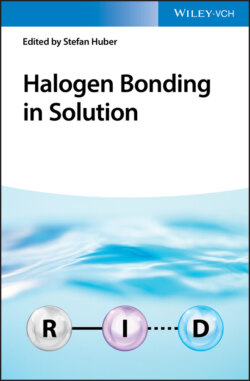Читать книгу Halogen Bonding in Solution - Группа авторов - Страница 11
1.1 Introduction
ОглавлениеThe group 17 elements, known as halogens, are diatomic species in their elemental form with the chemical formula X2 (where X = F, Cl, Br, I)1. In nature, they are seldom found in this manner due to their reactivity and thus are often presented as covalent or ionic species. However, the physical state of diatomic halogens provides initial insight into their capacity for noncovalent interactions. Moving down group 17, the elemental species exist in different phases from gas (F2 and Cl2) to liquid (Br2) to solid (I2). For simplicity, this observation is attributed to greater intermolecular dispersion forces afforded by the larger, more polarizable halogens and is quantifiable by physical properties such as boiling and melting point. This is the explanation that young chemists generally receive when being introduced to halogenated species and their physical properties. Later, in many organic curricula, these elements are presented as covalently bound components of molecules and are discussed within the context of molecular and bond dipoles, often in conjunction with concepts of electronegativity. Once again, the enhanced dispersion capacity of the halogens is often highlighted, explaining the higher boiling points of haloalkanes over hydrocarbons of comparable size and shape (e.g. ethane bp = −89 °C and bromomethane bp = 4 °C). Ultimately, the role of halogens in noncovalent interactions is neglected, giving way to their participation in classic reactions such as radical, substitution, and elimination pathways, which predictably leads to the misconception that halogens are simply electronegative leaving groups. This oversight is often reinforced in upper‐level courses, where halogens are shown to be the reactive site in many cross‐coupling reactions. Additionally, in classical inorganic chemistry, halides are depicted as weak field ligands and as prototypical examples in hard–soft acid–base theory. Even discussions of covalently bound halogens participating as hydrogen bond acceptors are atypical in university curricula.
In summary, halogens have traditionally been perceived as electronegative reactive species that participate in weak nondirectional noncovalent interactions (dispersion and as weak hydrogen bond acceptors). So how did scientists discover the ability of halogens to participate in a very directional and potent (comparable with hydrogen bond strength) noncovalent interaction, where the halogen is an electropositive species that is attracted to Lewis bases? To answer this, one should start with the definition of the halogen bond provided by the IUPAC in 2013 [2]. Then, early contributions from scientists who acknowledged an attractive interaction (more significant and directional than dispersion) can be acknowledged. Following the historical contributions, this introduction recounts the rediscovery of the halogen bond near the turn of the twenty‐first century. Finally, the chapter concludes by highlighting impactful nonsolution‐based examples that have helped construct the current understanding of the halogen bond, thereby providing context for the ensuing chapters on solution phase chemistry.
